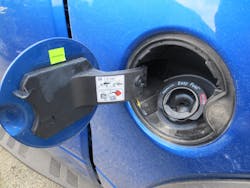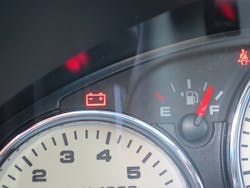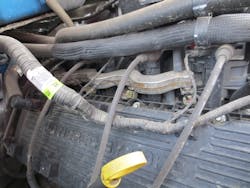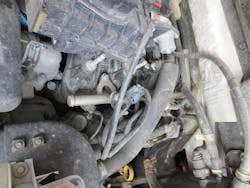Remember when checking a fuel system for correct operation meant checking that fuel was simply present at the injectors? Those days are all but gone. Most of today’s systems are returnless, so the old diagnostic methods of clamping off return lines to isolate issues aren’t in much use anymore. As well, modern direct injection systems use extremely high pressures that can’t be safely or accurately tested with the same gauges and testers that have worked well for years.
The problem with fuel system faults is that they can seem to be an awful lot like other system faults. For example, rough-running and back firing could be caused by an ignition system problem or it could be a fuel system problem. And a no-start condition could be caused by problems in any or all of the engine management subsystems — ignition mechanical, ignition or fuel. No doubt, figuring out what’s going wrong and putting it right can be quite a challenge.
However, diagnosing these systems still involves understanding the problems that could be causing the fault, creating an educated guess as to what the cause of the problem is and then taking measurements to verify or disprove your theory just as with any other vehicle control system. It’s just the tools and technology that have changed.
Working on these systems does take a bit more effort and knowledge and there really aren’t any magic bullets or one-size-fits-all rules thatPreliminary Steps
Since it usually takes a while to realize that a vehicle’s problem is fuel-related rather than any other system-related, time is of the essence in testing the fuel system components and that’s why a good preliminary inspection is so important.
The most important part of the preliminary inspection is taking a few moments to review how the system works and also understand how to test the components properly, making sure to review not only system operation but also to understand what pressures, voltages and parameters to expect during operation for two reasons.
The first reason this is essential is because the systems operate differently, with direct injection systems often using extremely high pressures (up to 2,000-plus psi) that can cause serious injury to techs that go in unprepared. Modern fuel systems deserve the same healthy respect as high-voltage electrical systems or extremely hot exhaust components. They require special safety considerations to prevent damage or injuries. Understanding how to relieve system pressures and how to test components and check operating pressure safely is critical.
The second reason is to make sure that what you’re trying to fix is actually a problem and not a normal operating condition. Many vehicles use multispeed fuel pumps to vary pressure when more or less is needed, so it's really important to know what the fuel pressure should be under various operating conditions. Chasing a low pressure situation that’s actually normal (because of a variable-speed fuel pump or an ECM (Engine Control Module) override condition (such as clear flood or theft deterrent) can be time consuming and embarrassing. Monitor what the pump is commanded to do by using a capable scan tool.
One excellent tip is to have a look at the fuel gauge as part of the preliminary inspection and note if the vehicle has just been filled up – something a tech who worked in an area known for discount fuel stations taught me. In fact, having the service advisor ask the customer about recent fuel purchases is a good idea if you can manage it. A drivability problem, like a misfire that develops immediately after a fill-up, may indicate bad or contaminated fuel problems and its better to realize that early on in the diagnosis than figuring it out late in the day. When a vehicle with Distributorless Ignition (DIS) has multiple and random cylinder misfire Diagnostic Trouble Codes (DTCs), from experience it’s almost always caused by the fuel. If each cylinder has its own ignition coil, the only thing that can really cause most of the cylinders to misfire at the same time is the one thing they have in common, the fuel. (Well, OK, the random multiple cylinder misfire could be caused by low fuel pressure too, but then there would be starting issues and other problems as well.) In other words, check if the fuel level is at maximum and be suspicious if it is.
And of course, look for bulletins and tech tips, and even for programming updates in your service information sources. Realistically, most customers use the Internet to look up their vehicle’s symptoms so it’s smart to quickly do the same– even though you may not find anything accurate or applicable this step is an important preliminary check.
Fuel Pressure and Volume
Fuel system problems tend to be caused by a lack of pressure or volume, poor quality fuel, or problems in the fuel control system (electrical control components). The trick is finding out which one it is — quickly and without damaging anything.
Testing system pressure usually is pretty straightforward. Attach the correct gauge to the service fitting and check that pressure is within specifications with the key on, engine off (KOEO). If there’s no port to connect the gauge to, then relieve the pressure in the fuel system as directed by service information and install the tester inline using the correct fittings (also as directed by service information and your tool’s manufacturer). Never simply press the valve core of the service fitting with a screwdriver or similar device to see if fuel pressure is present. At 2,000 psi if pressure is present, it will do a whole lot of damage and the results can be long-term injuries or expensive broken components. Not good at all.
The correct fuel pressure gauge and diagnostic tester are essential for verifying correct operation and diagnosing any concerns. Vehicle systems using direct injection have extremely high high-side pressure (in excess of 2,000 psi on some systems), and using a conventional gauge to check pressures might not be possible or advisable. True, the gauge might be able to check the tank supply or primary pump pressure but it won’t be able to check the high side of the system where many problems are found.
In these cases, many manufacturers have built pressure sensors into the fuel system so that the fuel pressure can be checked safely on a diagnostic tester. This also allows for the fuel systems to be tested dynamically to confirm the pump and other equipment are operating correctly under different loads. Service information will have the specifications , and I can share from experience, if the actual pressure is close but not quite within specs then that might be the problem. On these systems “close enough” usually isn’t good enough, so paying attention to details matters.
If pressure and volume aren’t within specifications, then find out if the pump isn’t doing its job or if there’s a leak or blockage somewhere in the system (it doesn’t take much to plug up those tiny little passages). One very smart tech I work with swears by having a shut off valve in the gauge connection to help isolate the engine and tank sides when checking for fuel pressure loss, so he can distinguish between a loss on the injector side or a problem with the fuel pump.
If you suspect that the injectors are leaking (not uncommon on high-pressure systems), pull out the engine oil dipstick and look (and sniff) for signs of fuel leaking past the rings and into the engine oil. Common indications include an oil level that is far too high, a noticeable fuel smell, or even the ability to ignite the oil (gas, really) on the dipstick with a pocket lighter.
If the problem is indeed the pump, quickly look and see if you notice something that would have caused the failure. Nearly every fuel pump manufacturer I know says dirt or sludge in the fuel tank is a common cause of pump failure (and failing to clean the tank leads to new pump failure and a comeback that could have been prevented). Another common cause is voltage drop in the pump circuit. Fixing the cause of the problem can prevent the new components from failing and the vehicle returning.
Once you’re ready to install the new pump, fill it up with fuel and let it sit for a moment so that it doesn’t start dry and possibly cause damage or premature wear. Replacing the fuel filter and screen (if applicable) at the same time as the pump (if it doesn’t come as part of the unit) is cheap insurance against repeat failures as is also filling it up with fuel before installing it and starting the vehicle. One final step to ensure a quality repair is never reusing O-rings and only using approved ones to complete the job. Successfully diagnosing and repairing modern fuel systems means paying attention to small details to ensure an accurate, lasting repair.
Restrictions and Debris
If the pump is OK, then make sure the fuel lines or filter aren’t restricted or plugged. This seems to happen more often on vehicles that are frequently driven on an empty tank or that use poor quality gas.
A wise tech I know used to sell fuel filter replacements by pointing out that all the fuel in the tank was pumped, filtered and recirculated every few hours so it was important to keep the fuel filter free from contaminants. This logic isn’t true anymore, because on returnless systems only the amount of fuel needed is pumped off to the injectors and fuel filters are often located in the tank as part of the sending unit and are intended to work for the “lifetime” of the vehicle.
Point out to your customers that driving around on an empty tank is likely to cause problems and encourage them to use quality fuels when they fill up. Additionally, when repairing or servicing the system, stick to high quality parts from trusted manufacturers and suppliers (this isn’t the place to get frugal; it’s nice when the vehicle starts easily and runs well and repeatedly dropping the fuel tank to replace components is simply not fun). Pay attention to details like using the correct engine oil because it matters and affects engine operation — it’s not one oil for all vehicles anymore. In other words, there’s certainly money to be made in preventative maintenance and it’s easier on everyone involved.
Conclusion
Diagnosing newer fuel injection systems can be challenging, but using the right tools and information make it much easier and profitable to deal with — actually it’s also the only way to deal with it. Diagnosing these systems — and all other systems — means developing a theory about what could be wrong and then taking measurements to prove or disprove that theory.
The important things to remember when working on these systems are to understand the system and know what you should see during your diagnosis and what to check if it’s not there — and remember to depressurize the system before working on it and keep the repair area very clean. Pay attention to details because small things make a big difference.
Repairing and maintaining these systems isn’t cheap, so there’s definitely money to be made if you’re willing to take on the challenges. Use the correct tools, understand the system and pay attention to small details and you’ll be just fine — and your bottom line will thank you for it.







